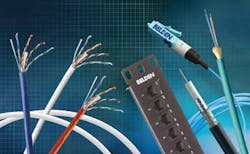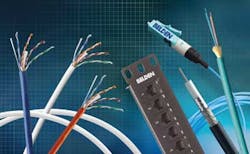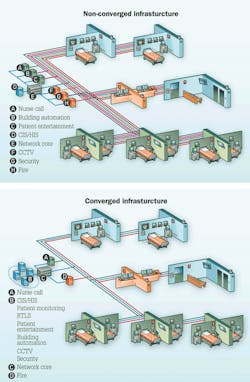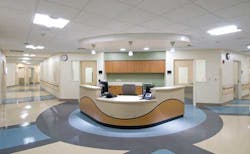Evolution of healthcare IT drives migration to IP-converged Ethernet
New TIA-1179 standard reinforces the need for a high-performance, scalable and streamlined architecture.
By Andre Mouton, Belden
With information technology (IT) becoming so vital to the healthcare industry in recent years, many healthcare facilities are finding it challenging to keep up. Their operating expenses continue to rise because of an aging population, increased chronic illness, industry and government regulations, and rising consumer demands for improved services and patient care.
To control costs and improve the safety and accountability of healthcare systems, governments are putting pressure on hospitals and healthcare providers to increase their use of electronic health records (EHR), using standards-based communications technologies. These initiatives are spurring many hospitals to upgrade their IT platform by consolidating multiple systems and applications on a centrally controlled infrastructure–the low-voltage cabling system supporting the facility's wired and wireless voice, data and video communications.
IT convergence has proven to be an effective way to reduce network complexity and lower administration time and costs. Traditionally, most hospital administrative and medical systems were installed on separate networks. As applications have expanded, however, the cost and complexity of maintaining disparate systems also increased. To minimize total cost of ownership, while boosting the quality of patient care, hospital administrators, medical staff and clinical support personnel all need to work and operate more efficiently. Too often in the past, the lack of swift, integrated information flow impeded the collaboration required to deliver prompt and responsive patient care.
Belden's Category 6 IBDN System 2400, the components of which are shown here, is used for voice, data, video and wireless communications. The cables are terminated in TRs on Belden's GigaFlex high-density 48-port patch panels.
This article describes how migration to a converged Internet Protocol (IP)-enabled Ethernet network can help hospitals improve performance and efficiency, while significantly reducing IT implementation and maintenance time and costs.
Healthcare facilities today typically have a great many technology-based systems and applications, all of which are viable candidates for IP convergence on a robust cabling infrastructure. Among these systems are the following.
- Clinical information systems (CIS) designed to collect, store and retrieve clinical information and images such as EHRs, laboratory and diagnostic testing data, and computerized physician order entry (CPOE) systems.
- Patient monitoring systems, dedicated systems that monitor individual patients' vitals and issue alarms when their vital signs fall outside set parameters.
- Nurse call systems, which are used to call nurses, doctors, orderlies and other support staff, using designated tones, lights, voice communications or other forms of communication.
- Interactive patient systems that use a patient's television or bedside terminal to create two-way communications or provide access to the hospital's information and entertainment services.
- Voice systems, using Voice over Internet Protocol (VoIP) to enable low-cost telephone communications, call forwarding, recording and instant messaging.
- Intercom systems, including overhead paging, public address systems, operating room sound systems, emergency alerts and more.
- Security systems, including CCTV surveillance, access control, life safety alarm systems and, in some hospitals, facility-wide radio-frequency identification (RFID) and real time location systems (RTLS) to monitor patients and protect hospital assets and equipment.
- Building automation systems used to control basic building functionality, such as HVAC, energy management, temperature, humidity and lighting control, and facility-wide clock synchronization.
- Audio-visual (AV) systems designed to provide full audio and video capabilities in auditoriums, meeting and conference rooms, employee lounges, patient rooms and other areas.
IP convergence and TIA-1179
With healthcare network infrastructure now having to support so many clinical and non-clinical applications, and to transmit and store volumes of digital information, migrating to a centrally controlled, standards-based IT and communications platform makes a great deal of sense. Recognizing this, the Telecommunications Industry Association (TIA; www.tiaonline.org) responded by ratifying the ANSI/TIA-1179 Healthcare Facility Telecommunications Infrastructure Standard, which specifies requirements above and beyond those required by commercial cabling standards.
To support mission-critical healthcare technology systems and IP convergence, the new standard addresses the need for the cabling infrastructure to provide high performance, increased cabling density, and the need to allow for future growth. It also makes key recommendations regarding design and installation practices based on specific healthcare environments and applications.
Building in performance and uptime
As the foundation of a converged IP network, the cabling infrastructure must ensure resiliency, reliability for maximum uptime, and easy implementation and management of new applications. To achieve these goals, healthcare facility administrators, IT managers, security chiefs and designated medical professionals must work closely with the network design and installation team to ensure that the cabling infrastructure is planned and deployed to provide optimal performance levels and the desired levels of redundancy and security.
As graphically depicted by the colored lines in these illustrations, the communications media required for converged systems in a hospital environment are fewer and less complex than those required for non-converged systems.
Relative to topology and length, the standard specifies the same hierarchical star topology requirements and backbone, as well as horizontal cable lengths, as those set forth in the TIA-568-C Commercial Building Standard.
When it comes to selecting signal transmission media, TIA-1179 recommends using the highest performing media whenever possible and specifies Category 6A cabling capable of supporting 10 Gbits/sec for all new healthcare installations. With the proliferation of digital diagnostic imaging, such as CAT scans and MRIs, high-performing media makes a huge difference in transmission speeds. For example, a 9,000-Mbyte file takes more than a minute to download over a 1-Gbit/sec network. The same file takes only about seven seconds over a 10-Gbit/sec network. For physicians caring for patients in an emergency situation, this amount of time can be the difference between life and death.
The new standard also makes provisions for cabling route diversity and redundancy by requiring a minimum of two diverse cabling pathways between the main service entrance facility, data center, telecom rooms, and any space considered a critical care area. It also specifies that the cabling infrastructure must reliably support technologies such as Power over Ethernet, VoIP and video over IP, and facility-wide wireless mobility.
In addition, the standard goes well beyond these recommendations and requirements to address needs and environmental conditions specific to hospitals and other healthcare settings. It covers issues related to infection control requirements, security and segregation of the life-safety portions of the network, higher work-area outlet density and other topics. That is why it is so important for system designers, integrators and installers to familiarize themselves with the new TIA-1179 standard and work with industry-leading technology providers that can supply the kind of end-to-end solutions required in mission-critical healthcare facilities.
The ROI of IP convergence
Healthcare facilities that have already installed an IP converged network infrastructure have reported up to a 20-percent savings in installation time and labor costs. However, that is just the beginning of the potential long-term return on investment.
With healthcare facilities expected to last for several decades, building with the best technology available to meet current and future needs means avoiding the expense and disruption of frequent upgrades and replacement down the road. In addition, providing the highest possible bandwidth and reliability right from the start results in greater operational efficiency, faster information flow, increased collaboration, improved patient care, maximum reliability and faster, easier network system maintenance. These longer-term benefits, both quantitative and qualitative, also contribute to ROI, as well as a lower overall total cost of ownership. And that is good news for owners and managers of today's healthcare facilities.
One hospital's journey to convergence
St. Peter's Hospital, a 442-bed acute care facility in Albany, NY began a major modernization plan to establish a world-class, high-tech, patient-focused hospital for the 21st century. The initiative includes major physical improvements, including a new 215,000-square-foot patient care pavilion, the addition of 22 surgical suites and significant increases in the number of private rooms.
A key goal in the hospital's multi-phased project is to provide advanced technology and efficiency with a converged network infrastructure that supports both clinical and non-clinical systems. Previously, the facility's network infrastructure comprised cabling and connectivity components from a variety of vendors. With construction of the new pavilion, however, management wanted an integrated network infrastructure able to support a multitude of systems and applications.
According to the hospital's chief information officer, members of the planning team experienced an "A-ha" moment in which they realized the critical role the cabling infrastructure would play in the overall performance and reliability of the entire network. This understanding led to the decision to standardize on an end-to-end, low-voltage network cabling system, complete with guaranteed throughput and a certified performance warranty, all sourced from an industry-leading vendor. St. Peter's chose Belden as its vendor of choice, with installation performed by a highly trained Belden certified system vendor (CSV).
To date, the St. Peter's Hospital IP converged network encompasses several patient care systems, mobile access EHRs, diagnostic imaging, nurse call, sound and video communications, entertainment and patient/guest services, VoIP phones, building automation and control, and a facility-wide wireless system. PoE is deployed to power phones, wireless access points, clocks and other devices over the network cabling. Addition of more biomedical systems is also planned.
The modernization project at St. Peter's Hospital allowed convergence of its clinical and non-clinical systems over the IP-based network infrastructure. This encompasses several patient-care systems, mobile access EHRs, diagnostic imaging, nurse call, sound and video communications, entertainment and patient/guest services. Pictured here is a nurse station in the hospital's patient care pavilion.
All of these systems communicate via IP, allowing fast, accurate information flow between applications as desired. System modularity and long-term sustainability were also concerns in order to avoid future upgrade expenses and disruptions to 24/7 uptime that might impact efficient operations and patient care.
These goals led the team to specify Belden's Category 6 high-performance IBDN System 2400 for voice, data, video and wireless communications. Color-coded cables were used to differentiate various network segments–blue for voice and data, orange for critical biomedical systems, white for security devices. In the new pavilion's nine telecommunications rooms (TRs), the cables terminate in Belden's GigaFlex high-density 48-port patch panels, which come preloaded with modular jacks that can be easily replaced if needed. Belden's zero-U management bars are used on the front of the panels in the racks to enhance aesthetics and facilitate cable management.
The pavilion's small data center connects to the hospital's main data center, and each TR connects to the data centers, using Belden FiberExpress singlemode fiber, terminated with FiberExpress field-installable LC-type fiber connectors. This backbone provides full redundancy and a network speed of 10 Gbits/sec. More than 200 Belden Quadshield RG6 coaxial cables were run to deliver video content to display boards and patient-room TVs, and stranded audio cables are used for the paging system.
State-of-the-art "hybrid" operating room for cardiac and vascular surgeries allows both minimally invasive and interventional surgical technologies through use of advanced medical imaging and communications technologies. The result is more efficient workflows, optimized throughput and more streamlined, coordinated patient care.
Today St. Peter's Hospital's new patient care pavilion is up and running, complete with a converged network infrastructure designed to support advanced medical technologies, improve operational efficiency and enhance patient care. The next phase of the hospital's modernization plan involves renovation of another half-million square feet of clinical space, in which the same standard will be implemented.-A.M.
Andre Mouton is vertical marketing director for Belden's Enterprise Group (www.belden.com).
Past CIM Issues



